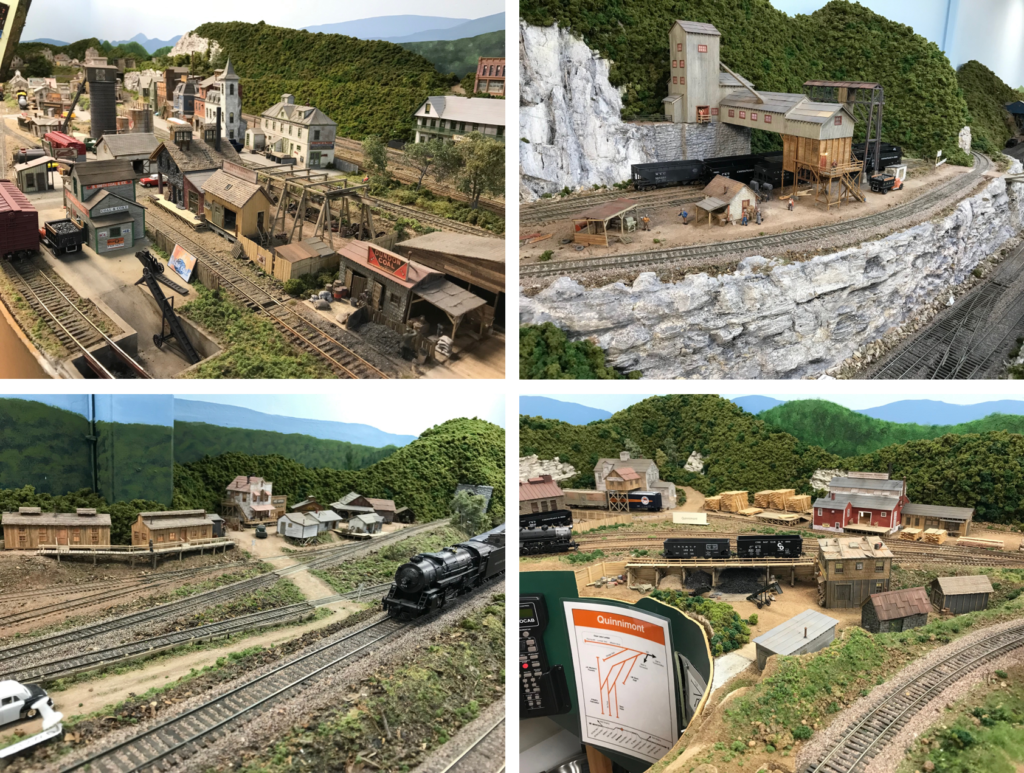There will be layouts open each day of the convention and a couple open after. The layouts shown below will be open. There are a total of 42 operating slots available. For convention attendees, please use the link below to register your interest in specific operating sessions. All of operating layouts are open also, see the open layouts for more details.
Thursday, April 25 – 1-5 PM
Robert Bowdidge – SP Vasona Branch, 4 operators – San Jose
The Vasona Branch layout models the Santa Clara Valley – now Silicon Valley – in the early 1930’s. “I aim to reproduce actual track arrangements, buildings, and scenes along the prototype San Jose – Los Gatos – Santa Cruz branch. I’ve used Sanborn fire insurance maps, railroad valuation maps, and historic photos to recreate lineside buildings and scenes, and researched the local fruit industry to help me understand the operation of the industries and likely traffic.”
The layout is a two-deck 10′ by 14′ HO layout in half of a two car garage, arranged as a point-to-point layout with staging yards on each end. Track is complete, most rough scenery is in, and some finished scenery is done. Operations is heavily skewed towards switching, with two-man local switch jobs handling the canneries, packing houses, and other industries along the line. Occasional commute trains keep the crews watching the 2-1 fast clock. Some trains also make the scenic run over the hill to Santa Cruz.
Layout control is via EasyDCC wired throttles. Motive power are the small steam engines seen on the actual branch. Most locomotives are sound-equipped, and crews are encouraged to use the whistle and bell prototypically. Much of the layout runs in “yard limits”, but automatic block signals and informal timetable and train order dispatching controls the track over the hill as on the prototype. Switching is done from computer-generated switch lists.
The Vasona branch runs a 4 hour session; 4 operators are needed for the two crews.
More information on the layout can be found at: http://www.vasonabranch.com/railroad/vasona.html and in my blog on the historic research and modelbuilding progress at http://vasonabranch.blogspot.com.
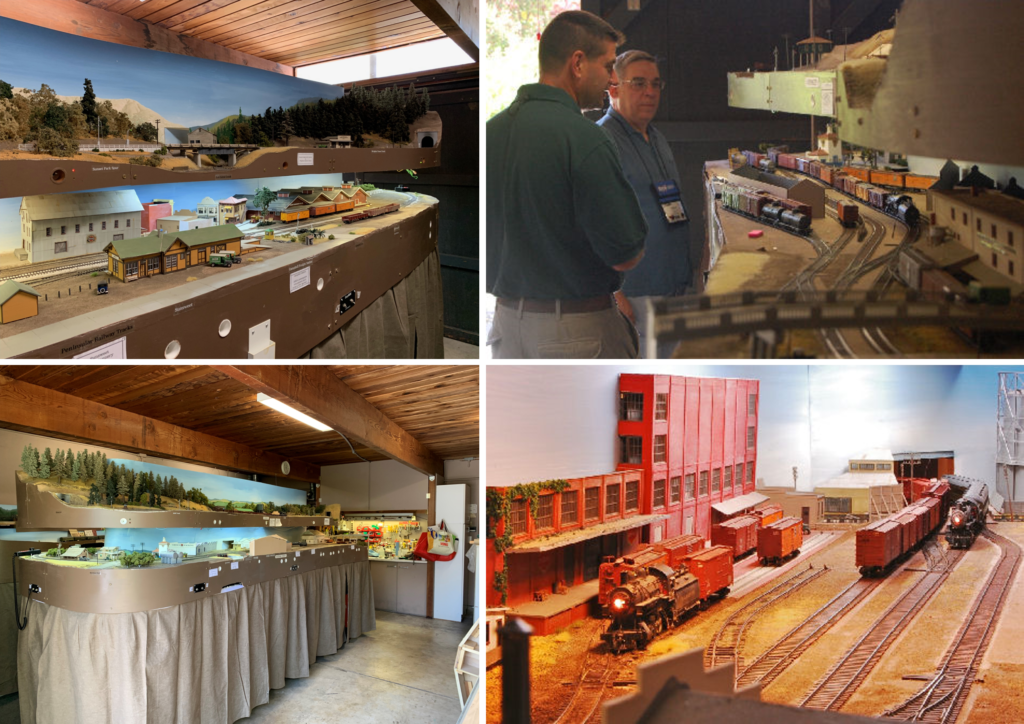
Friday, April 26 – 12:30-4:30 PM
Jim Radkey – The BNSF Pink Lady Sub (HO) Freelanced, 8-10 operators – Albany
The BNSF Pink Lady Subdivision is based on the finding of the Pink Lady Mine (PLM) in the Warner Mountains, located in the extreme North Eastern corner of California. The PLM was established in 1975 after the discovery of Pink Unobtainium (PU). PU has been a gold mine so to say to the prospectors and the region the mine is located. PU has found many uses that were never imagined until some crazy industrious Model Railroaders started to invent uses for PU. Even though the actual uses of PU are well guarded national secrets, known only by a selected few, it has been rumored, that PU can be found in numerous production processes from steel to soda pop. In short time the spur line for the mine was overwhelmed with traffic that originated on and off the spur. With these demands it only seemed logical to make this a bridge route. After an extensive review of satellite imagery and tricky legal negotiations a bridge route was planned, fundraising was obtained, and construction of the BN PLSD was begun. The bridge would be between Bieber, CA and Boise, Idaho. The traffic was very heavy with connections to the Northern routes of the Burlington Northern R.R. and a Southern Route to connections via the Western Pacific R.R. The Eastern gateway was a fast run to Canada, Salt Lake City, and all points east. New towns and industries were formed making the Pink Lady a very busy subdivision. It is now the 1990s and the BN, ATSF, WP, DRG&W, and the IC have all merged to create a Railroad empire to take on the UP. The merger name is Burlington Northern Santa Fe (BNSF) and this is the Pink Lady Subdivision.
The actual BNSF PLSD occupies a 21 by 17 foot California basement (a garage) and was designed with operation in mind. There are three decks of track work that flow around the room hugging the walls on three walls and protrudes into the room on a peninsula. The track work starts and ends in big looped staging areas. The subdivision includes 5 towns, 4 passing sidings, a ten track yard, a two turn helix, the Pink Lady Mine and numerous industries.
During an operating session the train line up includes locals, drag freights, through traffic and extras as required. We usually run 10 to 20 trains during a session. There is enough operating for 8 to 10 operators including a yardmaster with two assistants and a dispatcher. Car movements are generated by car cards. Train movement is by Track Warrant Control (TWC). Communications is by two-way FRS radios. Operations are meant to be purposeful but relaxed. If you are not having fun I have not been successful.
The track work is code 83 flex track laid on cork, pink foam and plywood. The layout is controlled by NCE/System One DCC. Wireless and tethered throttles are currently being used. The electrical system has automatic reverse loops and power shield protection that is broken down into 5 blocks. The mainline run is approximately 250 feet. Mainline minimums include: #6 or greater turnouts, 2.5 % or less grades, 30 inch or greater radius. Turnouts are controlled by Tortoise switch machines and caboose hobbies ground throws. 100% of the mainline is laid with the engine facility being the only track work left to be laid. Currently the layout has about 20 percent of the scenery in place. I am using Bragdon Rocks for the mountain scenery and various structures for modern industries.
Note that Albany is 43 miles from the hotel and will take about an hour to reach and over an hour to return due to traffic. The session is planned to start so you will need to miss the last morning clinic on Friday, April 26.
I look forward to meeting you at ProRail 2024 and I hope you have a fantastic operating experience.
Jim Radkey
Superintendent
BNSFPLSD
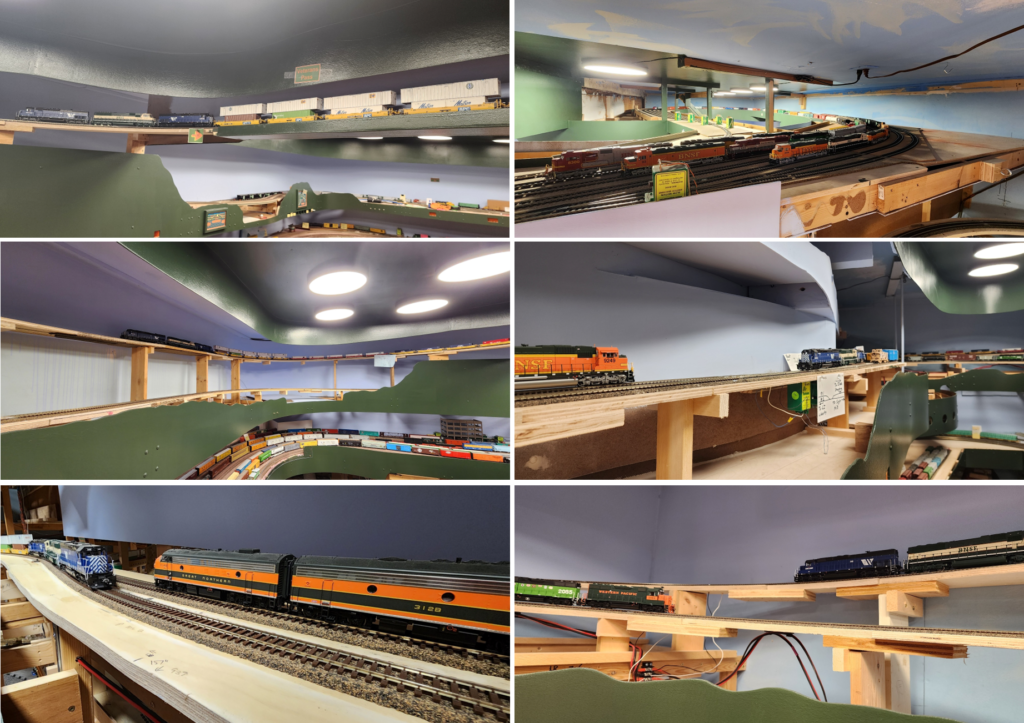
Saturday, April 27 12:30-4:30 PM
Dave Loveless – Southern Pacific Coast Division Monterey Branch. aka R&D RR, 11 operators – Watsonville
The railroad models the Southern Pacific Coast division in 1941 and is designed and built for operations. It resides in a purpose-built 24′ X36′ building, with a double deck lift gate for easy egress. The railroad is double-decked, with the Southern Pacific Coast Division from Gilroy to Salinas on the lower deck and the Monterey Branch on the upper deck. The decks are connected by a single- track 5 level, custom built hidden helix that is equipped with sensors to indicate the location of a train.
The layout has a 12 track staging yard. Each track is a through track, with the South representing King City/San Luis Obispo/Los Angeles and the North end representing San Jose/ San Francisco /Roseville.
The layout currently has 100% of the track in place. 66 FastTrack turnouts have been built and installed. Turnouts are Fast Tracks ~118 (73 done, 45 left). Scenery has just started but most scenes are mocked up with models and temporary structures.
The layout is NCE DCC controlled with wireless throttles, and hand thrown turnouts. Dispatching is done using TT&TO over telephones. Concise documentation of all train operations is provided to assist operators in stepping into a new job.
Crew positions:1 dispatcher, 2 Train Order Operators, 3 yard men, 5 train operator. Emphasis is on switching; yards and towns
Dave’s Website is Southern Pacific Coast Division Monterey Branch
Note this layout is about 58 miles and about 1 hour from the hotel but much of the ride is through beautiful “Steinbeck Country” that will be brilliant green following this winter’s rains! The session is planned to start so you will need to miss the last morning clinic on Saturday, April 27.
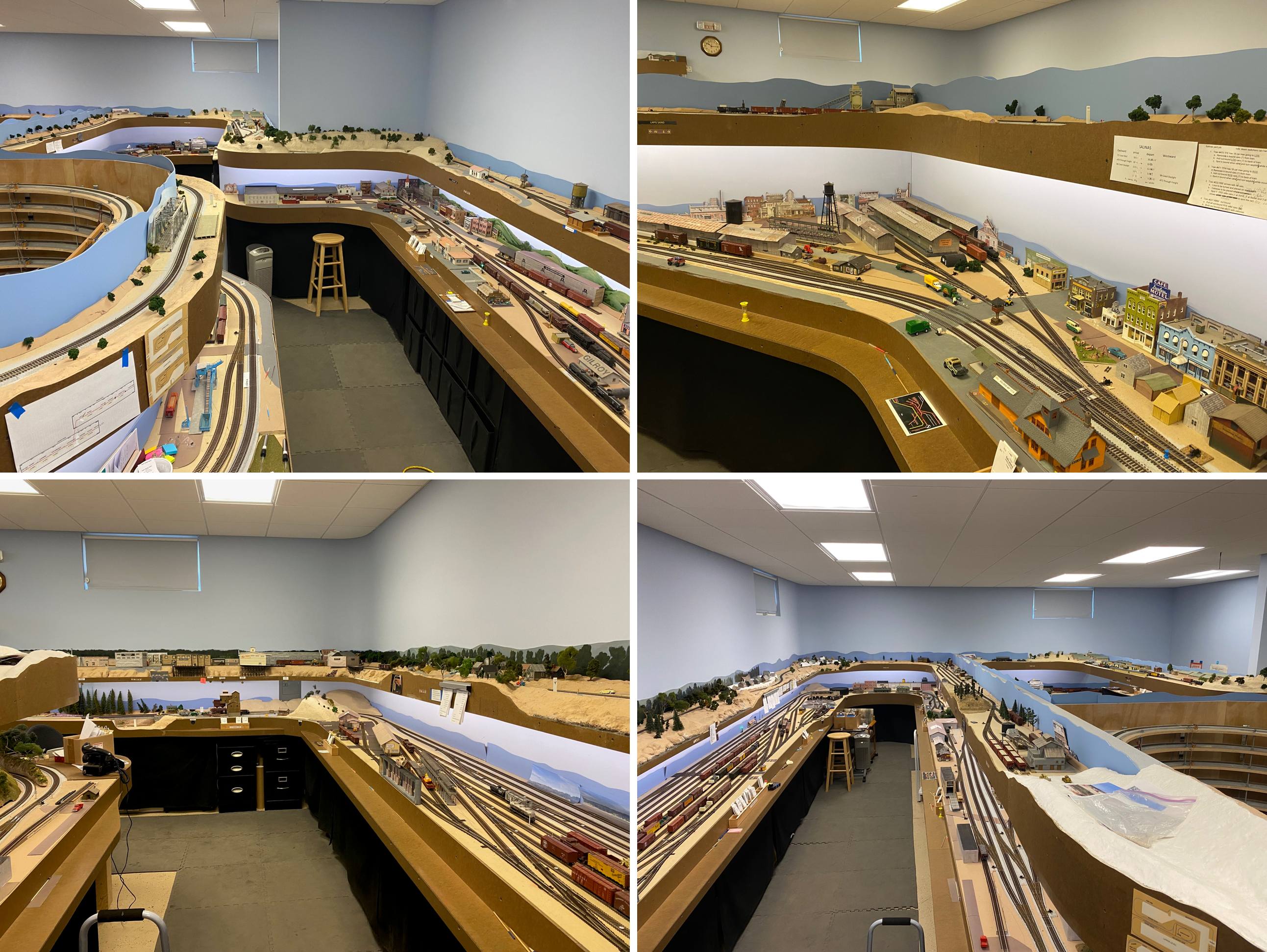
Sunday, April 28, 2024 – 12-5 PM
Seth Neuman – Union Pacific Oakland Sub, 8 operators – Mountain View
The layout is set in the East Bay in 1999. The railroad represents the former Western Pacific 1st and San Jose Subdivisions, which had become the UP Niles, Oakland and Milpitas Subdivisions in the era modeled. The railroad is a secondary main and a branchline which supports an Auto plant (NUMMI), a large gravel operation and a number of smaller industries.
The layout is built in a 450 sqft purpose built room. Construction is single level. Dispatching is by TCS (using CATS) which replicates a Digicon console. Signal control is by CMRInet, including cpNodes made by Seth’s company, Model Railroad Control Systems. All signals are repeated as color lite signals on repeaters above the layout. There is a complete writeup of the layout in Volume 52 of the Layout Design Journal, publication of the Layout Design SIG and a cover story in RMC January 2018 and a cover in NMRA Magazine July 2021.
The layout is about 95% sceniced.
A unique feature of the layout is that there is no yardmaster, only a Clerk. This is because the prototype Milpitas Yard has no permanent switcher. The clerk is responsible for managing yard and the neighboring NUMMI complex by writing switchlists to instruct the crews where to place cars. All crews do their own work when passing through the yard.
A typical session runs about 5 hours and uses 8 operators. Jobs include: Dispatcher, Clerk, NUMMI Job (2 crew, 2 shifts), UP LRV54 Local, BNSF trackage rights local, and the Mission Bay local which inlcudes a utility job called “The Critter Wrangler”.
NCE DCC with wireless throttles, all mainline engines have sound decoders, FRS Radios, 2:1 fast clock, switchlists. Uncoupling 100% manual using pics.
Schedule Notes: Seth runs from 9:30 AM to 4:00 PM. He is about 12 miles from San Jose International Airport and 30 miles from SFO, for your Sunday getaway.
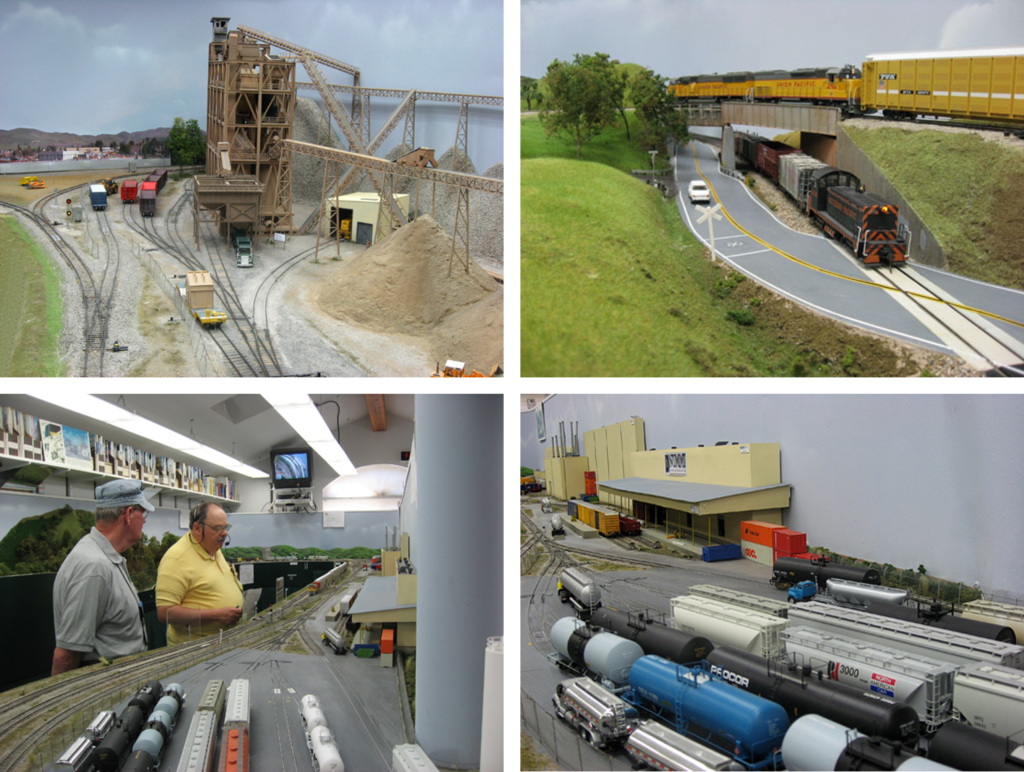
Sunday, April 28, 2024 – 1-5PM – Mountain View
Ted Stephens – Ohio & Little Kanawha Railroad, 9 operators – Mountain View
The Ohio & Little Kanawha Railroad is a freelance 1950s West Virginia coal hauling railroad. It takes you on a journey through the rolling hills of West Virginia, through small towns and big cities.
This HO scale railroad features 250 feet of mostly hand laid single and double track mainline. All turnouts and track are scratch built using Fast Tracks assembly fixtures. Operations are designed around the layout’s two yards, four towns and two large and one small coal mine. Both local switching jobs and long mainline runs characterize the operations scheme. The layout features many scratch built and contest winning craftsman structures. Scenery is almost 100% complete.
The layout is built in a 750 square foot room of an industrial building. The main layout room is 50 x 15 with a branch in an adjacent room. Construction is single level.
With a Yard Master and 4 crews, a typical ops session lasts about 4 hours.
Operation and Control:
- NCE-DCC with wireless throttles
- Car forwarding by car cards and waybills
- Dispatching via pseudo-CTC with trackside telephones
- Manual uncoupling using picks
- All mainline engines are equipped with sound decoders
